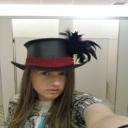Yahoo Answers is shutting down on May 4th, 2021 (Eastern Time) and the Yahoo Answers website is now in read-only mode. There will be no changes to other Yahoo properties or services, or your Yahoo account. You can find more information about the Yahoo Answers shutdown and how to download your data on this help page.
Trending News
I need help picking a fabric for a cape please?
http://www.unique-vintage.com/unique-vintage-black...
I purchased this dress, and need to make a floor length cape to go with it. I don't want it to be chiffon like the dress because I don't want it to float away if I go outside and there is wind, but I also don't want it to be too heavy that it makes me look frumpy. The goal is to look somewhat regal.
So what is a good material to make a cape out of that would go with this dress? Anyone with knowledge of sewing or costuming, your answers are appreciated.
Purely fashion. I don't have questions about color, I already know what I'm going to use. I just don't have a lot of knowledge of fabrics
2 Answers
- ?Lv 76 years agoFavorite Answer
I love the styles from that era. For something very simple and basic a nice crepe backed satin would make a true to the era cape. Crepe backed satin is a little heavier than a standard satin, so it drapes beautifully, hangs well and flows and shimmers like a river. Taffeta and the similar moire is also true to the era -although I hesitate to recommend taffeta for anything -modern acetate taffeta is my second least favorite fabrics for sewing. Polyester taffeta is better but hard to find. Also true-to-the-era would be velvet with a lighter satin lining Back in the day the satin lining would be painted (or embroidered) with designs near openings and corners so that if the cape flipped open in the breeze the designs were visible. Fur would be used at the collar. Sometimes the insides of the capes were more embellished and fancier than the outsides. When you made your entrance at an event you would stand with arms outstretched and everyone would admire your lining, or something. I have a Delineator fashion magazine from 1927 explaining how to make a proper entrance in just that way!
Observations from my collection of clothes and patterns from the era: Many satin and velvet capes would also be reversible and both sides decorated. I guess the velvet was for cold nights and the satin side for warm evenings? I have several short capes in satin and velvet and one has remnants of strands of beads that hung from the clasp at the neckline. For warmth wools similar to modern melton cloth - called fulled wool or boiled wool -would be used and again lined with a softer satin. I have a few sewing patterns that suggest boiled wool on the outside and silk satin, bengaline or taffeta or moire on the inside. Very very expensive capes were lined with chamois skin or exotic furs sheared to a velvet-like length or even finely woven cashmeres. Cashmere is good for a cape if you have lots of money sitting around and nothing else to spend it on! One of my vintage capes has rags of painted chamois skin attached at a few places along the facing edges. from a pattern envelope: Wools such as fulled and boiled wool (melton) can be over-dyed , appliqued, embroidered an more by the home seamstress. Adding vinegar to regular dry goods store dye turns it into an acid dye for wools.
Also popular back in the era were "cocoon coats" If you were part of high society in Paris would would wear a genuine Paul Poiret cocoon coat. These were made from everything from soft silks and satins for summer to wools and heavy lined silk velvet for cold evenings. Collars were trimmed with furs and the edges were decorated with fancy metallic braids, beads sequins and more. The sky was the limit with these embellished coats -it was impossible to be too bright or too shiny or too expensive. If you look up Paul Poiret Cocoon Coat you'll find some spectacularly preserved examples. Here's a pattern for the original designer coat of the era: http://www.folkwear.com/503.html
this one
http://truebias.com/2014/03/diy-cocoon-cardigan.ht... is a simple modern adaptation of a cocoon coat only made from fleece. the long coats were made from similar shapes.
I know that was far more than you asked for and asked a few weeks ago, but YA is so messed up that I didn't have in my feed until now, and sometimes I like to ramble on when talking about a subject I enjoy.
- 6 years ago
Is it meant to keep you warm? Silver flannel. If it's for fashion, I'd use silk.


